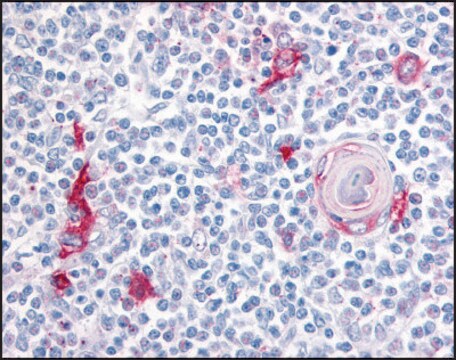MABC1795
Anti-phospho-TERT (Thr249) Antibody, clone TpMab-3
Synonim(y):
EC:2.7.7.49, HEST2, TP2, Telomerase catalytic subunit, Telomerase reverse transcriptase, Telomerase-associated protein 2
About This Item
Polecane produkty
pochodzenie biologiczne
mouse
Poziom jakości
forma przeciwciała
purified antibody
rodzaj przeciwciała
primary antibodies
klon
TpMab-3, monoclonal
masa cząsteczkowa
calculated mol wt 127 kDa
observed mol wt ~127 kDa
oczyszczone przez
using protein G
reaktywność gatunkowa
human
opakowanie
antibody small pack of 100
metody
immunofluorescence: suitable
immunohistochemistry: suitable
western blot: suitable
izotyp
IgG1κ
sekwencja epitopowa
N-terminal half
numer dostępu Protein ID
numer dostępu UniProt
temp. przechowywania
2-8°C
informacje o genach
human ... TERT(7015)
Specyficzność
Immunogen
Zastosowanie
Isotype testing: Identity confirmation by Isotyping Test.
Isotyping Analysis: The identity of this monoclonal antibody is confirmed by isotyping test to be mouse IgG1k.
Tested Applications
Immunofluorescence Analysis: A representative lot detected TERT in Immunofluorescence applications (Matsuda, Y., et al. (2022). J Pathol. 257(2):172-185).
Western Blotting Analysis: A 1:250 dilution from a representative lot detected TERT in Mitotic HeLa cells with RO3306 treatment (negative) versus mitotic HeLa cell samples (positive), where the positive control samples were obtained by IP using clone 10E9-2 to enrich hTERT ( Data courtesy of Dr. Kenkichi Masutomi, National Cancer Center Research Institute, Tokyo, Japan).
Western Blotting Analysis: A representative lot detected TERT in Western Blotting applications (Matsuda, Y., et al. (2022). J Pathol. 257(2):172-185).
Immunohistochemistry Applications: A representative lot detected TERT in Immunohistochemistry applications (Matsuda, Y., et al. (2022). J Pathol. 257(2):172-185).
Note: Actual optimal working dilutions must be determined by end user as specimens, and experimental conditions may vary with the end user.
Opis wartości docelowych
Postać fizyczna
Rekonstytucja
Przechowywanie i stabilność
Inne uwagi
Oświadczenie o zrzeczeniu się odpowiedzialności
Nie możesz znaleźć właściwego produktu?
Wypróbuj nasz Narzędzie selektora produktów.
Kod klasy składowania
12 - Non Combustible Liquids
Klasa zagrożenia wodnego (WGK)
WGK 1
Temperatura zapłonu (°F)
Not applicable
Temperatura zapłonu (°C)
Not applicable
Certyfikaty analizy (CoA)
Poszukaj Certyfikaty analizy (CoA), wpisując numer partii/serii produktów. Numery serii i partii można znaleźć na etykiecie produktu po słowach „seria” lub „partia”.
Masz już ten produkt?
Dokumenty związane z niedawno zakupionymi produktami zostały zamieszczone w Bibliotece dokumentów.
Nasz zespół naukowców ma doświadczenie we wszystkich obszarach badań, w tym w naukach przyrodniczych, materiałoznawstwie, syntezie chemicznej, chromatografii, analityce i wielu innych dziedzinach.
Skontaktuj się z zespołem ds. pomocy technicznej